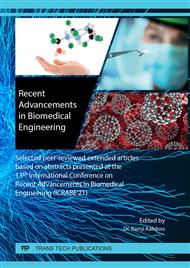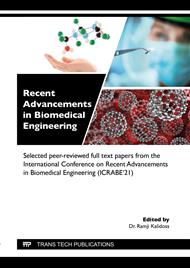[1]
B. Caulfield, B. Reginatto, P. Slevin, Not all sensors are created equal: a framework for evaluating human performance measurement technologies, NPJ digital medicine, 2 (2019)1-8.
DOI: 10.1038/s41746-019-0082-4
Google Scholar
[2]
P. Mohankumar, J. Ajayan, R. Yasodharan, P. Devendran, R. Sambasivam, A review of micromachined sensors for automotive applications, Measurement, (2019).
DOI: 10.1016/j.measurement.2019.03.064
Google Scholar
[3]
H. Huang, P.-Y. Chen, C.-H. Hung, R. Gharpurey, D. Akinwande, A zero power harmonic transponder sensor for ubiquitous wireless μL liquid-volume monitoring, Scientific reports, 6 (2016) 1-10.
DOI: 10.1038/srep18795
Google Scholar
[4]
J. Ponmozhi, C. Frias, T. Marques, O. Frazão, Smart sensors/actuators for biomedical applications, Measurement, 45 (2012) 1675-1688.
DOI: 10.1016/j.measurement.2012.02.006
Google Scholar
[5]
C.L. Ng, M.B.I. Reaz, Evolution of a capacitive electromyography contactless biosensor: Design and modelling techniques, Measurement, (2019).
DOI: 10.1016/j.measurement.2019.05.031
Google Scholar
[6]
S. Updike, G. Hicks, The enzyme electrode, Nature, 214 (1967) 986-988.
DOI: 10.1038/214986a0
Google Scholar
[7]
A. Rachkov, S. McNiven, A. El'skaya, K. Yano, I. Karube, Fluorescence detection of βestradiol using a molecularly imprinted polymer, Analytica chimica acta, 405 (2000) 23- 29.
DOI: 10.1016/s0003-2670(99)00743-6
Google Scholar
[8]
S. Kröger, A.P. Turner, K. Mosbach, K. Haupt, Imprinted polymer-based sensor system for herbicides using differential-pulse voltammetry on screen-printed electrodes, Analytical Chemistry, 71 (1999) 3698-3702.
DOI: 10.1021/ac9811827
Google Scholar
[9]
S. McNiven, M. Kato, R. Levi, K. Yano, I. Karube, Chloramphenicol sensor based on an in situ imprinted polymer, Analytica chimica acta, 365 (1998) 69-74.
DOI: 10.1016/s0003-2670(98)00096-8
Google Scholar
[10]
I. Karube, T. Matsunaga, S. Suzuki, T. Asano, S. Itoh, Immobilized antibody-based flow type enzyme immunosensor for determination of human serum albumin, Journal of Biotechnology, 1 (1984) 279-286.
DOI: 10.1016/0168-1656(84)90019-1
Google Scholar
[11]
H. Muguruma, I. Karube, Plasma-polymerized films for biosensors, TrAC Trends in Analytical Chemistry, 18 (1999) 62-68. [13] M.D. Mitsubayashi K, Yamada T, Kawase T, Karube I, In: Eur Conf Solid-State Transducers, Prague, Czech Republic, 2002, p.772–775.
DOI: 10.1016/s0165-9936(98)00098-3
Google Scholar
[12]
C. O'sullivan, G. Guilbault, Commercial quartz crystal microbalances–theory and applications, Biosensors and bioelectronics, 14 (1999) 663-670.
DOI: 10.1016/s0956-5663(99)00040-8
Google Scholar
[13]
B. Liedberg, C. Nylander, I. Lunström, Surface plasmon resonance for gas detection and biosensing, Sensors and actuators, 4 (1983) 299-304.
DOI: 10.1016/0250-6874(83)85036-7
Google Scholar
[14]
J. Craig Venter, M. Adams, E. Myers, P. Li, R. Mural, G. Sutton, H. Smith, M. Yandell, C. Evans, R. Holt, The sequence of the human genome, Science, 291 (2001) 1304-1351.
Google Scholar
[15]
E. Lander, L. Linton, B. Birren, C. Nusbaum, M. Zody, J. Baldwin, K. Devon, K. Dewar, M. Doyle, W. FitzHugh, Consortium IHGS, Linton LM, Birren B, Nusbaum C, Zody MC, Baldwin J, Devon K, Dewar K, Doyle M, et al: Initial sequencing and analysis of the human genome. Nature, 409 (2001) 860-921.
Google Scholar
[16]
A. Manz, D.J. Harrison, E.M. Verpoorte, J.C. Fettinger, A. Paulus, H. Lüdi, H.M. Widmer, Planar chips technology for miniaturization and integration of separation techniques into monitoring systems: capillary electrophoresis on a chip, Journal of Chromatography A, 593 (1992) 253-258.
DOI: 10.1016/0021-9673(92)80293-4
Google Scholar
[17]
S.-W. Tsai, M. Loughran, A. Hiratsuka, K. Yano, I. Karube, Application of plasmapolymerized films for isoelectric focusing of proteins in a capillary electrophoresis chip, Analyst, 128 (2003) 237-244.
DOI: 10.1039/b207871f
Google Scholar
[18]
Yousaf, T.; Dervenoulas, G.; Politis, M. Advances in MRI Methodology. Int. Rev. Neurobiol. 2018, 141, 31–76.
Google Scholar
[19]
Hemond, C.C.; Bakshi, R. Magnetic resonance imaging in multiple sclerosis. Cold Spring Harb. Perspect. Med.2018, 8, 1–21.
DOI: 10.1101/cshperspect.a028969
Google Scholar
[20]
Behzadi, A.H.; Farooq, Z.; Newhouse, J.H.; Prince, M.R. MRI and CT contrast media extravasation. Medcine2018, 97 S.H. Lee, J.H. Sung, T.H. Park, Nanomaterial-based biosensor as an emerging tool for biomedical applications, Annals of biomedical engineering, 40 (2012) 1384-1397.
DOI: 10.1007/s10439-011-0457-4
Google Scholar
[21]
Lux, J.; Sherry, A.D. Advances in gadolinium-based MRI contrast agent designs for monitoring biological processes in vivo. Curr. Opin. Chem. Biol. 2018, 45, 121–130.
DOI: 10.1016/j.cbpa.2018.04.006
Google Scholar
[22]
Liu, X.; Madhankumar, A.B.; Miller, P.A.; Duck, K.A.; Hafenstein, S.; Rizk, E.; Slagle-Webb, B.; Sheehan, J.M. Connor, J.R.; Yang, Q.X. MRI contrast agent for targeting glioma: Interleukin-13 labeled liposome encapsulating gadolinium-DTPA. Neuro. Oncol. 2016, 18, 691–699.
DOI: 10.1093/neuonc/nov263
Google Scholar
[23]
McMahon, M.T.; Bulte, J.W.M. Two decades of dendrimers as versatile MRI agents: A tale with and without metals. Wiley Interdiscip. Rev. Nanomed. Nanobiotechnol. 2018, 10, e1496.
DOI: 10.1002/wnan.1496
Google Scholar
[24]
Moghimi, H.; Zohdiaghdam, R.; Riahialam, N.; Behrouzkia, Z. The assessment of toxicity characteristics of cellular uptake of paramagnetic nanoparticles as a new magnetic resonance imaging contrast agent. Iran. J.Pharm. Res. 2019, 18, 2083–(2092).
Google Scholar
[25]
Rogosnitzky, M.; Branch, S. Gadolinium-based contrast agent toxicity: A review of known and proposed mechanisms. BioMetals 2016, 29, 365–376.
DOI: 10.1007/s10534-016-9931-7
Google Scholar
[26]
Layne, K.A.; Dargan, P.I.; Archer, J.R.H.; Wood, D.M. Gadolinium deposition and the potential for toxicological sequelae – A literature review of issues surrounding gadolinium-based contrast agents. Br. J. Clin. Pharmacol.
DOI: 10.1111/bcp.13718
Google Scholar
[27]
Dong, Y.C.; Hajfathalian, M.; Maidment, P.S.N.; Hsu, J.C.; Naha, P.C.; Si-Mohamed, S.; Breuilly, M.; Kim, J.;Chhour, P.; Douek, P.; et al. Effffect of gold nanoparticle size on their properties as contrast agents for computed tomography. Sci. Rep. 2019, 9, 1–13.
DOI: 10.1038/s41598-019-50332-8
Google Scholar
[28]
Silvestri, A.; Zambelli, V.; Ferretti, A.M.; Salerno, D.; Bellani, G.; Polito, L. Design of functionalized gold nanoparticle probes for computed tomography imaging. Contrast Media Mol. Imaging 2016, 11, 405–414.
DOI: 10.1002/cmmi.1704
Google Scholar
[29]
Nakagawa, T.; Gonda, K.; Kamei, T.; Cong, L.; Hamada, Y.; Kitamura, N.; Tada, H.; Ishida, T.; Aimiya, T.;Furusawa, N.; et al. X-ray computed tomography imaging of a tumor with high sensitivity using gold nanoparticles conjugated to a cancer-specifific antibody via polyethylene glycol chains on their surface.Sci. Technol. Adv. Mater. 2016, 17, 387–397.
DOI: 10.1080/14686996.2016.1194167
Google Scholar
[30]
Mok, P.L.; Leow, S.N.; Koh, A.E.H.; Mohd Nizam, H.H.; Ding, S.L.S.; Luu, C.; Ruhaslizan, R.; Wong, H.S. Halim, W.H.W.A.; Ng, M.H.; et al. Micro-computed tomography detection of gold nanoparticle-labelled mesenchymal stem cells in the rat subretinal layer. Int. J. Mol. Sci. 2017, 18, 345.
DOI: 10.3390/ijms18020345
Google Scholar
[31]
Farooq Aziz, A.I.; Nazir, A.; Ahmad, I.; Bajwa, S.Z.; Rehman, A.; Diallo, A.; Khan, W.S. Novel route synthesis of porous and solid gold nanoparticles for investigating their comparative performance as contrast agent in computed tomography scan and effffect on liver and kidney function. Int. J. Nanomed. 2017, 12, 1555.
DOI: 10.2147/ijn.s127996
Google Scholar
[32]
Chen, J.; Yang, X.Q.; Qin, M.Y.; Zhang, X.S.; Xuan, Y.; Zhao, Y.D. Hybrid nanoprobes of bismuth sulfifidenanoparticles and CdSe/ZnS quantum dots for mouse computed tomography/flfluorescence dual mode imaging. J. Nanobiotechnol. 2015, 13, 1–10.
DOI: 10.1186/s12951-015-0138-9
Google Scholar
[33]
Santos, B.S.; Ferreira, M.J. Positron emission tomography in ischemic heart disease. Rev. Port. Cardiol. 2019,38, 599–608.
Google Scholar
[34]
Lee, S.B.; Lee, S.W.; Jeong, S.Y.; Yoon, G.; Cho, S.J.; Kim, S.K.; Lee, I.K.; Ahn, B.C.; Lee, J.; Jeon, Y.H. Engineering of radioiodine-labeled gold core-shell nanoparticles as effiffifficient nuclear medicine imaging agents for traffiffifficking of dendritic cells. ACS Appl. Mater. Interfaces 2017, 9, 8480–8489.
DOI: 10.1021/acsami.6b14800
Google Scholar
[35]
Chakravarty, R.; Hong, H.; Cai, W. Image-guided drug delivery with single-photon emission computed tomography: A review of literature. Curr. Drug Targets 2015, 16, 592–609.
DOI: 10.2174/1389450115666140902125657
Google Scholar
[36]
Estudiante-Mariquez, O.J.; Rodríguez-Galván, A.; Ramírez-Hernández, D.; Contreras-Torres, F.F. Medina, L.A. Technetium-radiolabeled mannose-functionalized gold nanoparticles as nanoprobes for sentinel lymph node detection. Molecules 2020, 25, (1982).
DOI: 10.3390/molecules25081982
Google Scholar
[37]
Wang, Y.; Li, Y.; Wei, F.; Duan, Y. Optical imaging paves the way for autophagy research. Trends Biotechnol.2017, 35, 1181–1193.
DOI: 10.1016/j.tibtech.2017.08.006
Google Scholar
[38]
Wu, W.; Yang, Y.Q.; Yang, Y.; Yang, Y.M.; Wang, H.; Zhang, K.Y.; Guo, L.; Ge, H.F.; Liu, J.; Feng, H. An organic NIR-II nanoflfluorophore with aggregation-induced emission characteristics for in vivo flfluorescence imaging.Int. J. Nanomed. 2019, 14, 3571–3582.
DOI: 10.2147/ijn.s198587
Google Scholar
[39]
K. Wise, R. Weissman, Thin films of glass and their application to biomedical sensors, Medical and biological engineering, 9 (1971) 339-350.
DOI: 10.1007/bf02474087
Google Scholar
[40]
J. Shin, Y. Yan, W. Bai, Y. Xue, P. Gamble, L. Tian, I. Kandela, C.R. Haney, W. Spees, Y. Lee, Bioresorbable pressure sensors protected with thermally grown silicon dioxide for 3 (2019) 37-46.
DOI: 10.1038/s41551-018-0300-4
Google Scholar
[41]
H. Tao, S.-W. Hwang, B. Marelli, B. An, J.E. Moreau, M. Yang, M.A. Brenckle, S. Kim, D.L. Kaplan, J.A. Rogers, Silk-based resorbable electronic devices for remotely controlled therapy and in vivo infection abatement, Proceedings of the National Academy of Sciences, 111 (2014) 17385-17389.
DOI: 10.1073/pnas.1407743111
Google Scholar
[42]
S.-K. Kang, R.K. Murphy, S.-W. Hwang, S.M. Lee, D.V. Harburg, N.A. Krueger, J. Shin, P. Gamble, H. Cheng, S. Yu, Bioresorbable silicon electronic sensors for the brain, Nature, 530 (2016) 71-76.
DOI: 10.1038/nature16492
Google Scholar
[43]
G. Appelboom, E. Camacho, M.E. Abraham, S.S. Bruce, E.L. Dumont, B.E. Zacharia, R. D'Amico, J. Slomian, J.Y. Reginster, O. Bruyère, Smart wearable body sensors for patient self-assessment and monitoring, Archives of public health, 72 (2014) 28.
DOI: 10.1186/2049-3258-72-28
Google Scholar
[44]
L. Sheng, S. Teo, J. Liu, Liquid-metal-painted stretchable capacitor sensors for wearable healthcare electronics, Journal of Medical and Biological Engineering, 36 (2016) 265-272.
DOI: 10.1007/s40846-016-0129-9
Google Scholar
[45]
S. Carreiro, K. Wittbold, P. Indic, H. Fang, J. Zhang, E.W. Boyer, Wearable biosensors to detect physiologic change during opioid use, Journal of medical toxicology, 12 (2016) 255-262.
DOI: 10.1007/s13181-016-0557-5
Google Scholar
[46]
J.C. Yeo, C.T. Lim, Emerging flexible and wearable physical sensing platforms for healthcare and biomedical applications, Microsystems & Nanoengineering, 2 (2016) 1-19.
DOI: 10.1038/micronano.2016.43
Google Scholar
[47]
N.J. Ronkainen, H.B. Halsall, W.R. Heineman, Electrochemical biosensors, Chemical Society Reviews, 39 (2010) 1747-1763.
DOI: 10.1039/b714449k
Google Scholar



